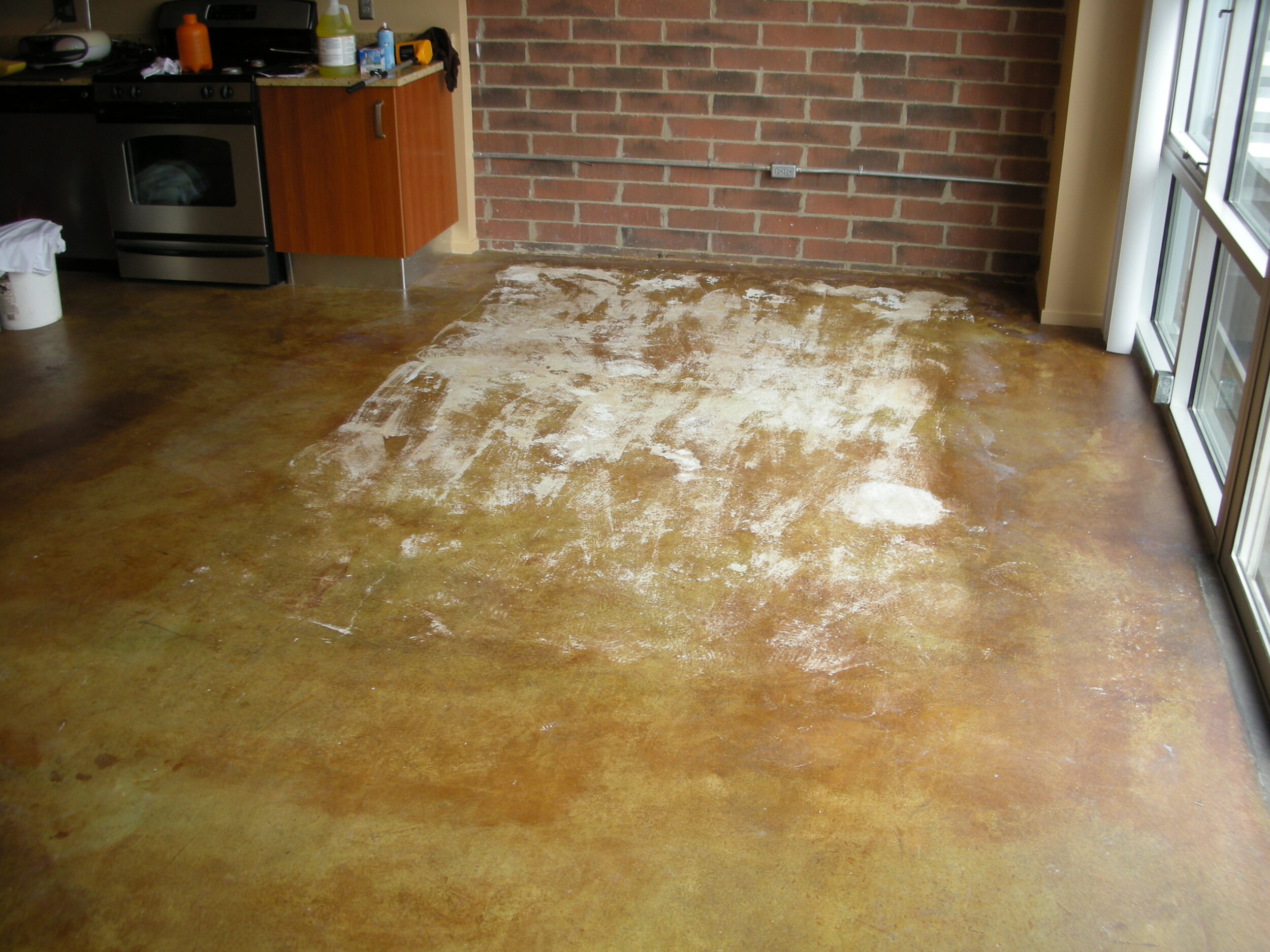Acid-stained concrete is ever growing in its popularity as a form of flooring for homes and businesses. We built our business around it at Premier Veneers. We install almost exclusively acid-stained concrete, and we have a detail-specific maintenance page on our website for our customers so that they can keep their new floors looking great indefinitely. Not everyone wants to do that maintenance, though, so we also take on that responsibility for some of our customers.
Above is a photo of work we are doing in a North Chicago basement to strip an existing sealer from an integrally colored gray concrete floor. The original flooring contractor applied the sealer over all kinds of paint drips and other blemishes, without first cleaning the floor.
But what is the difference between “maintaining” an acid-stained concrete floor, and “refurbishing” it?
At Premier Veneers, we do both. The basic difference is that with maintenance, you are starting with a brand new, great looking floor, and you want to keep it looking that way. You want to take steps that will preserve your investment, and provide the floor indefinite durability. You may have had the floor installed yourself, or you may have purchased a home or business from someone who installed the floor, and then was conscientious about keeping it looking great.
We have detailed maintenance instructions on this popular page of our website: www.ConcreteVeneers.com/maintenance .
With refurbishing, in contrast to maintenance, you may have a beautiful acid-stained concrete floor, but it’s not looking the way it used to. The gloss is gone, and there are all kinds of marks and blemishes on the floor that get more notice from people than the actual acid-stained concrete color and “mottling” (variation in shade and coloring). Black scuff marks from shoes show up, as well as paint, primer, and drywall mud drips from painters, discoloration from liquid spills, scratches from the moving of heavy furniture, and rubber residue from the backing of matting and carpet squares.
So while maintenance means simply following a prescribed routine for cleaning and waxing a floor, similar to a car, refurbishment means undoing damage to the floor, before renovating, brightening, and freshening it up. How do we “un-do” that damage? Well, it starts with a heavy duty cleaning, using a bio-friendly detergent, like Simple Green, so that you can clearly see the damage that needs to be undone.
This is the dining area of a Royal Oak, Michigan luxury condominium. The tenants put down rubber-backed carpet squares for a long time. When they moved out and pulled them up, the squares pulled the sealer and acid-stain color right off the floor.
What does a heavy duty cleaning involve? Basically, heavy duty cleaning means using a strong concentration of detergent, with warm water, and it means scrubbing, either with a rotary floor machine, fitted with a green-colored nylon pad, or a “doodle-bug” scrubbing pad at the end of a long, handheld pole. Once the scrubbing is done, you need to use a garden sprinkling can with warm water to rinse and shop vac up the remaining detergent residue.
There are two types of damage to an acid-stained concrete floor that need to be undone: topical, and structural. Topical marks are those that rest on the surface of the clear sealer that protects the acid stain. These marks don’t always come up with the first mopping, and often consist of white drips or spots, but also bright or contrasting colors that clearly don’t belong to the finish. The best way to get these marks up is with a flat edge scraper with a 4” razor insert. With a little patience, and caution, you can scrape these drips loose so that they can be vacuumed or mopped up.
Acetone is available at Lowe’s or Sherwin Williams for about $7 a quart, and will help you remove just about any topical mark or blemish from acid-stained concrete, most of the time without damaging the clear sealer.
For spots that don’t scrape up easily, the next best method is to dampen a cotton rag with acetone, and dissolve, and rub them out. Acetone is flammable and corrosive, though, so you have to be careful. Don’t use it around open flames, and make sure to wear a pair of nitrile rubber gloves, and open a window for plenty of ventilation. Also, since acetone will leave residue on the surface of the sealer, after it dries, make sure to mop the floor again afterward.
Most clear sealers used on acid-stained concrete are durable enough to withstand the above scraping and acetone “solvent rubbing”. And once you’ve finished with this topical cleaning, you’ll be able to see what type of “structural”, or permanent damage has been done to the sealer. If there’s a lot - scratches, marring, and scuffing - you’re going to want to reseal the floor with a new coat of clear sealer, like an epoxy. In most cases, that new coat of sealer will fill in and remove the above types of structural damage.
Sometimes, though, the structural damage goes all the way through the sealer into the floor itself, and has resulted in the loss of acid-stain coloring, like deep scratches that reveal the gray color of the concrete beneath the acid stain. For this type of damage, you’ll need to touch up the marks with the same color of acid stain, using a small artist brush from an arts and crafts store, like Michael’s.
If there isn’t much damage to the floor, you can then get by with just mopping on 2 or 3 light coats of a janitorial floor finish, like Spartan’s On ‘n On. But in most cases where you have a lot of topical damage, you’re also going to have a lot of structural damage. The good thing about epoxy clear sealers is that in the process of removing scratches, marring, and scuffing, a new coat also adds depth and new gloss to the floor. Once that new coat of sealer dries, then you can add the floor finish.
Above is a photo of work we are doing to strip the existing sealer from the stairway of a backyard patio. The stripper is white, and is allowed to work overnight, before we scrape it up and scrub the bare concrete with detergent.
Most well-installed acid-stained concrete can be maintained and refurbished by the home or business owner. It’s mostly a matter of time, and attention to detail. But there are some acid-stained concrete floors that require a major makeover, and nothing less will do. For example, concrete that is systemically damp, or that has been flooded, can completely ruin the clear sealer protecting the acid-stain coloring.
In most cases, what happens is that the moisture will try to evaporate from the concrete, due to the heat in a room, and then get trapped inside the clear sealer, making it “blush”, or turn white. This blush doesn’t go away over time, and may show up here and there across a majority of the floor. In cases like this, the sealer has been permanently damaged, and needs to be chemically “stripped” from the floor, before the floor is sealed anew, and then coated with new floor finish.
Stripping of clear sealer is tedious, and takes a lot of know-how, patience, and experience to do right. Done wrong, and you can permanently change and ruin the acid-stain coloring below.
If your acid-stained concrete needs maintenance, or refurbishing, hopefully this article helps you know which, and if it’s a project you can tackle yourself. If you need help, contact us at Premier Veneers. There aren’t many floors out there that we can’t fix and get looking great again.




